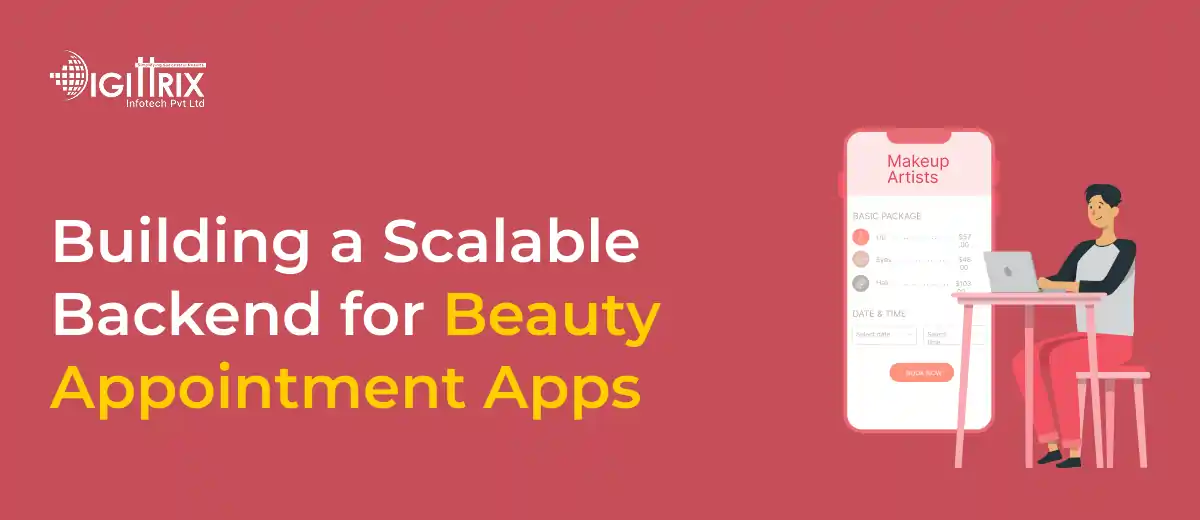The beauty appointment app market is expanding quickly, with more users seeking easy mobile booking and scalable backend systems that ensure smooth service.
Highlights
With Over 14 years of Experience in the IT Field, Helping Companies Optimise there Products for more Conversions

In recent years, the beauty industry has experienced a significant shift towards mobile technology. Beauty appointment apps have become a popular option for customers wanting to book salon, spa, or beauty services quickly and conveniently. For businesses aiming to enter this market, prioritising the development of beauty appointment apps is essential for offering a smooth and satisfying user experience.
Building an app that can handle increasing users and services efficiently requires a robust backend. This article guides you through creating a scalable backend for beauty appointment apps, highlighting key technical aspects and practical tips. Whether you're an Android or iOS developer or part of a beauty app development team, this guide explains what’s needed to support your app’s growth.
Planning to build a beauty service app? Learn the cost breakdown and key factors for developing a successful beauty service app in 2025.
Scalability refers to the ability of the backend to manage increasing numbers of users, appointments, and transactions without performance issues. When a beauty app gains popularity, thousands or even millions of users might try to book services simultaneously. Without a scalable backend, your app could become slow or unresponsive, causing frustration for customers and potential loss of business.
A well-designed backend can manage this growth smoothly, ensuring that user requests are handled quickly and appointments are confirmed without delay. This is especially crucial for an On-demand beauty appointment app, where customers expect prompt responses and real-time updates.
Before exploring the technical details of building the backend, it is important to understand the main features the backend needs to support for a beauty appointment app.
The backend should support all these features while being fast, secure, and capable of scaling with the user base.
The selection of backend architecture is crucial for scalability. Several architectural patterns are available for consideration:
This traditional approach involves building the entire backend as a single unit. While it’s easier to develop initially, it becomes more difficult to maintain and scale as the app grows. For a beauty appointment app, this might work at the start but could cause issues later on.
Microservices divide the backend into smaller, independent services that each handle specific tasks. For instance, one service might manage bookings, another could oversee payments, and another handle user management. This approach makes it easier to scale individual parts of the system according to demand.
Serverless computing enables developers to run backend code without managing servers. It automatically scales resources according to usage. This can be an economical choice for beauty apps, particularly those in the early stages.
For a scalable beauty appointment app development project, microservices or serverless architecture are often preferable choices because they provide flexibility and improved resource management.
The technology stack you choose for backend development impacts the app’s performance and scalability. Common options include:
Pair these with databases designed to scale well:
For beauty app development, it’s often useful to combine a SQL database for transactions with a NoSQL database for storing service details, user profiles, and logs.
A beauty appointment app manages sensitive user data such as personal details and payment information. The backend must be secure to safeguard users and adhere to regulations.
Use industry standards like:
Prioritizing security in mobile app development helps your app earn users’ trust and lowers the chance of data breaches.
The heart of a beauty appointment app is its booking system. The backend must:
Using a database with transaction support and locking mechanisms helps maintain the booking process's consistency. Caching frequently requested data, like available time slots, can speed up responses and lessen the load on the server.
For an on-demand beauty appointment app, offering instant booking confirmations is crucial for user satisfaction.
Notifications keep users updated about their bookings and encourage engagement. The backend must manage:
Using services like Firebase Cloud Messaging or AWS SNS can make this part of beauty app development easier by handling message delivery effectively.
Payment processing must be smooth and secure. The backend should:
A distinct separation between the payment system and other backend components improves security and supports scalability.
To keep the app running smoothly, you need to monitor backend performance, errors, and user activity. Using monitoring tools like Prometheus, Grafana, or New Relic helps identify problems early.
Gathering analytics on booking trends, popular services, and user behaviour also helps in making better business decisions for your beauty app development company.
As the number of users grows, the backend needs to be prepared to manage the additional load. Here are some common techniques:
Cloud platforms such as AWS, Google Cloud, or Azure offer tools and infrastructure to support scalability.
APIs are how the frontend app communicates with the backend. Well-designed APIs make it easier to add new features and keep the app well-maintained.
Consider:
This approach improves the user experience and reduces backend load.
Regular testing is essential to ensure that the backend operates properly under different conditions. Perform:
A thorough testing process reduces the chances of app crashes or errors during real use.
Building a scalable backend relies on collaboration among various types of developers.
Clear communication and using tools like Git for version control help the team stay aligned and productive.
If you're a business owner wanting to create a beauty appointment app but lack the technical resources, hiring a beauty app development company is a smart choice. These companies specialize in building apps that meet market needs and technical challenges.
A professional development company will:
Collaborating with experts guarantees your app's successful growth without technical hurdles.
Looking to enhance your beauty business? Learn how a beauty services app can streamline operations, boost customer retention, and increase revenue in 2025.
Building a scalable backend for a beauty appointment app involves several steps, including selecting the appropriate architecture, technologies, and design strategies. Focusing on performance, security, and flexibility ensures your app can accommodate a growing user base.
Whether you're an Android or iOS app developer, or part of a beauty app development company, focusing on a strong backend will help deliver a smooth and satisfying booking experience for clients. By planning carefully and using proven methods, your on-demand beauty appointment app can meet market needs and support long-term success.
In today’s fast-paced world, delivering seamless and personalised experiences is vital for beauty businesses. A scalable backend for your beauty appointment app should include key features such as real-time booking management, at-home service scheduling, and secure payment processing. These elements help beauty professionals provide prompt and efficient services while meeting increasing customer expectations.
Whether you're after a platform that can handle increasing client bookings, support customised beauty services, or streamline the appointment process, a skilled development team can build the ideal backend system. Using modern backend technologies designed for scalability, beauty apps can manage rising demand without slowing down, keeping your business competitive and dependable.
With extensive experience in beauty appointment app development, we specialise in creating backend solutions tailored to the unique needs of the beauty industry. Ready to develop a scalable backend for your beauty app? Book a consultation with our technical experts by calling +91 8727000867 or send your enquiries to digittrix@gmail.com.

Do you need help in Mobile App development?




Join over 1500+ businesses we've already helped!
Beauty App Development: Tips to Grow Your Business Through an App & Cost in India (2026)
Scalability ensures the app can handle more users and bookings without slowing down or crashing, providing a smooth experience as it expands.
Microservices and serverless architectures are popular because they allow for flexible scaling and better resource management.
Popular options include Node.js, Python (Django), Java (Spring Boot), and databases like PostgreSQL or MongoDB.
It uses transaction support, real-time availability checks, and caching to avoid double bookings and deliver quick confirmations.
Yes, partnering with a beauty app development company can supply expert developers to create a scalable and secure backend for your app.

©2026Digittrix Infotech Private Limited , All rights reserved.